Researcher: Youngbin Kim
Start Date: April 2014
End Date: July 2014
Overview
Kimchi is the most typical and essential fermented dish in Korea, comprising a range of ancient and diverse traditions. The goal of this project was to try to model traditional Kimchi recipes by their functional components and use this knowledge to make ‘Nordic’ analogues based on these principles. We include our most successful trial below, as well as some further applications of the pickles and the brine.
Introduction
Kimchi is the most typical and essential fermented dish in Korea. Koreans eat Kimchi at every meal every day, which along with the broad variety of vegetables used contributes to Koreans’ intake of beneficial nutrients and enjoyment of diverse Kimchi tastes. Koreans say that they feel something is missing if there is no Kimchi on the table and it is very normal to have two or three different types of Kimchi at one meal. Every household in Korea has a separate fridge only for ‘precious’ Kimchi, so-called ‘Dim-chae’, which keeps Kimchi at a constant temperature – usually between 5-10˚C though the user decides based on the maturity level they wish to prolong its period of edibility. Making Kimchi is one of the biggest and the most important family events. All family members gather to make Kimchi on ‘Kim-jang’ day and share their life stories and news. The mother and aunts teach the daughters how to make Kimchi under the instructions of the grandmother with their life-long experience for delicious recipes and techniques. Everyone has their own recipe or additional ingredients, so every home-made Kimchi has its own flavour depending on the unique family preference, where they live or when they made it. When Koreans travel abroad, they never forget to carry several packs of Kimchi in their luggage, as well try to find a Korean restaurant in the foreign country because Koreans cannot imagine the meal without Kimchi. Therefore, I dare say that Kimchi is a cultural icon of Korea and the core of Korean cuisine which is one of its most precious assets.
History
It is believed that Kimchi originated from the salted vegetable preparation called ‘Jeo’ (菹) in China, whose first written record dates to about 2000 years ago (Han et al., 2012). However, there is no written record of Jeo or Kimchi in Korea until the 10th century. It was first described in ‘Dong-guk-i-sang-guk-jip (동국이상국집, 東國李相國集, Collected Works of Minister Yi of Korea)’ from the 12th century that salted radish, turnip, and cabbage was made to be able to consume vegetables throughout the winter (Lee, 2000). This source indicates that the initial form of Kimchi was salted vegetables with or without grains and spices, which is quite similar to ‘Jang-a-jji’ (fermented vegetable with salt) in contemporary Korean cuisine (Lee, 2000). Since then or maybe before (it is not clear from the historical record), Kimchi was developed to include the condiments such as garlic, ginger, Chinese pepper, madder (Rubia tinctorum), windflower (Anemone spp.), and others, and then fermented (Park, 2005). The Chinese cabbage was first introduced to Korea much later, around the 17th or 18th century. Cultivation of red chili pepper started in the end of 16th century during the war against Japan, but it was first used in Kimchi only in the late 18th century (Han et al., 2012). The use of red chili pepper in Kimchi mainly began in order to reduce the amount of salt which was very expensive at that time (Lee, 2000). As well, it was also due to the practical property of chili which increased the edible period of Kimchi by slowing the fermentation, and likely also the appetising red colour it contributed. It was only around the late 19th or early 20th century when Kimchi settled into its current form made with Chinese cabbage and red chili pepper, which is the most famous and prototypical form of Kimchi nowadays (Park, 2005).
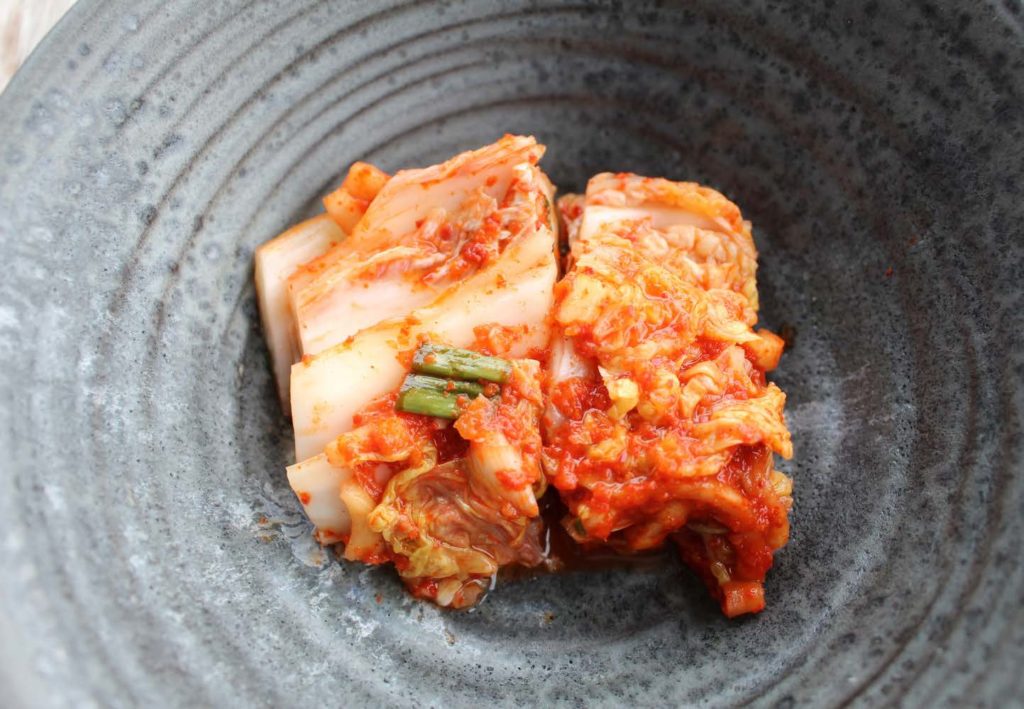
Brief overview of how to make Kimchi
1) Soak the Chinese cabbage in brine for few hours to reduce its water content and to kill undesirable microorganisms. Then, wash them thoroughly and strain.
2) Prepare all the spicing ingredients (garlic, ginger, red chili pepper, etc.) and grind them to make a sauce with rice or wheat porridge.
3) Chop the daikon and spring onion, and mix with the ground vegetables. It is common to add some fish sauce or other ingredients such as oyster sauce by one’s preference.
4) Fill each leaf of cabbage with the sauce, and put them into a container. Seal the container thoroughly, and store it at a proper temperature for the fermentation.
There are more than 200 kinds of Kimchi differing according to the types of vegetables and the addition of specific ingredients such as fish or meat. As previously mentioned the most common type of Kimchi is made mainly with Chinese cabbage (Napa cabbage), however, it varies by the seasonal main ingredients, geographical characteristics and processing method.
The Kimchi seasons
Korea has four distinct seasons, which also influences the Kimchi culture. Kimchi made of Chinese cabbage is common to prepare at the end of autumn before winter comes when the cabbage is harvested. In winter, white radish (daikon) is used to make watery white Kimchi which is called ‘Dong-chi-mi’. Newly-harvested cabbage, water parsley and mustard leaf are the main ingredients for spring Kimchi. Due to the high temperature in summer, it is usual to make short-term Kimchi with cucumber, young small radish stems and chives (doopedia). All year round, wild plants from mountainous areas are also one of the most common ingredients for making Kimchi. For example, ‘sesame leaf’ (Perilla spp.; unrelated to Sesame, Sesamum indicum), balloon flower root (Platycodon grandiflorus), pumpkin leaf, and other plants are used for making Kimchi according to the season.
Regional variation
As the northern part of Korea is colder, Kimchi in the north is less salty and less spicy because the fermentation happens more slowly and not as much salt/spiciness is needed to control it. The fishing in northern areas is stable throughout the year, therefore, there are many types of Kimchi fermented with fish such as cod, pollack, and flat-fish. Also it is common to pour more water in Kimchi, which explains why Dong-chi-mi (watery white radish Kimchi) is one of the most famous types of Kimchi in the north. The southern part of Korea is warmer and all sorts of seafood are abundant since it is surrounded by sea on three sides. There are many different types of fermented seafood in the south, which are also used to make Kimchi. These influences along with the higher temperature in the south have led to saltier and spicier Kimchi with strong and intense flavours, which helps to preserve the Kimchi longer in these conditions (doopedia).
The ‘vital trio’ and other ingredients
As additional ingredients, different sorts of vegetables such as radish, spring onion, and chives can be selectively used. For spicing, garlic, ginger and red chili powder (the vital trio of Kimchi) are now essential. It has been indicated that garlic’s antimicrobial properties help to prevent the spoilage of Kimchi, and its allicin improves the intake of vitamin B (Han et al., 2012). Capsaicin from red chili powder inhibits microbial metabolism which slows the acidification of Kimchi, which also helps to keep the good tastes of the amino acids (Kim et al., 1996). Fermented fish sauce called ‘Jeot-gal’ is regarded as a necessary ingredient in Korea, however, as mentioned above, it differs according to the region or family taste whether Jeot-gal is used in Kimchi or not. Jeot-gal itself is the product of lactic acid fermentation of seafood, so it is full of umami and accelerates the fermentation of Kimchi (Kim et al., 1996).
Kimchi microbiology and the ‘fermented taste’
Kimchi is mainly fermented by Lactic Acid Bacteria (LAB), which contribute to its distinct pungent tangy flavour. Lactobacillus spp.and Leuconostoc spp. different from those found in dairy products or in the human gut are, along with Weissella spp., the main genera responsible for the fermentation in all types of Kimchi (Ko et al., 2013, Jung et al., 2014). Chang et al. (2009) have shown that some strains of LAB in Kimchi are able to survive in the acidic conditions of the stomach, so they reach the intestine which promotes gut health and boosts the immune system. Therefore Kimchi has recently gained attention for its likely pro-biotic activities.
The flavour and texture of Kimchi is significantly determined by the fermentation conditions – for instance, the temperature, fermentation period, and storage materials. It is now common knowledge that Kimchi fermented at lower temperatures (5-10°C) shows less acidity than one at higher temperatures (15-20°C), and also has a longer edible period (Noh et al., 2009). This is why winter Kimchi has a longer period of good taste than summer Kimchi. Of course, the Kimchi stored for a long time is also more sour and shows a softer texture with a strong tangy flavour compared to the ones stored for a short period which have a less mature, more raw taste.
The storage material also matters. In Korea, Kimchi has traditionally been stored in Ong-gi (옹기) which means earthenware. Ong-gi is buried under the ground in wintertime to prevent the Kimchi from freezing and to keep a constant temperature. One study about Ong-gi (Jeong et al., 2011) revealed that there are the differences in Kimchi stored in Ong-gi compared to plastic containers, steel boxes and glass bottles. The structure of Ong-gi has micro-scale porosity, which helps the gas permeability of Kimchi and increases the multiplication of LAB. This facilitation enhances the antioxidant and anticancer properties of Kimchi, and stabilises its sour taste at a good level (Jeong et al., 2011).
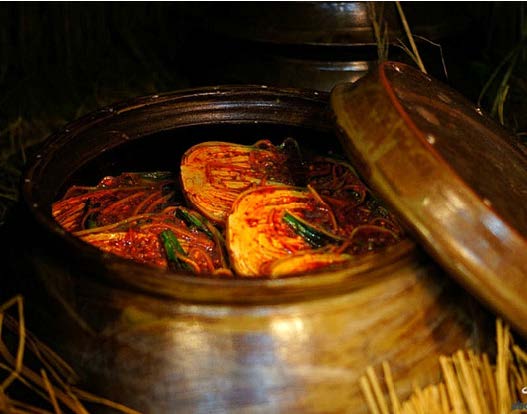
Fermentation can last more than one year, up to 3-5 years, then the whole taste and flavour are totally different from the beginning with lots of fermented taste harmonized between all the ingredients. It is said that this fermented taste (it’s called ‘삭은맛 (감칠맛)’, or the sixth taste in Korea) is a typical Korean taste, where all different ingredients are integrated and thus create a new special taste. It is very much alike Korean cultural philosophy, emphasizing the harmonization of different people and groups, which further strengthens the union of the whole nation (Kim, 1996).
‘Nordic’ Kimchi
Now we have better understanding of Kimchi. It is tasty, healthy, and efficient for preserving vegetables with lots of variety. As a Korean, I have been interested in making different types of Kimchi based on the cultural and geographical circumstances in Europe. I have seen many of my foreign friends try Kimchi, but they didn’t enjoy it because it was too hot-spicy or its funky fermented taste was too unique or strong. Therefore, the goal of my Kimchi project was to make Kimchi adapted to the Nordic region, not only with the ingredients but also for the cultural and flavour identity. I believe also that there must be potential for Kimchi in Central or Northern Europe since Sauerkraut and Kimchi share some kind of identity based on their roles in cuisine, their taste, and the fact that both are made by lactic acid fermentation of vegetables.
Red Kimchi made of chili powder is the most well-known worldwide, however, there are also white watery Kimchi made of radish with lots of garlic, ginger, and spring onion and no chili powder. Rice porridge (or wheat) is added to make sauce thicker so that it can cover all the ingredients well and stimulate the fermentation process. As chili powder, ginger and rice are not typically Northern European, we considered other ingredients with similar pungency and anti-bacterial properties. It was also important to find the best spicing trio for Nordic Kimchi like the essential three spicing ingredients of original Korean Kimchi – garlic, ginger, and red chili powder. Since the image of white Kimchi for me was watery, I started to make watery Nordic Kimchi, which means that all the ingredients are prepared and kept all together in a special brine for the fermentation. Several first trials turned out good and tasty, so I continued this way for making Nordic Kimchi. In addition, substituting the rice porridge was easily solved by using barley porridge.
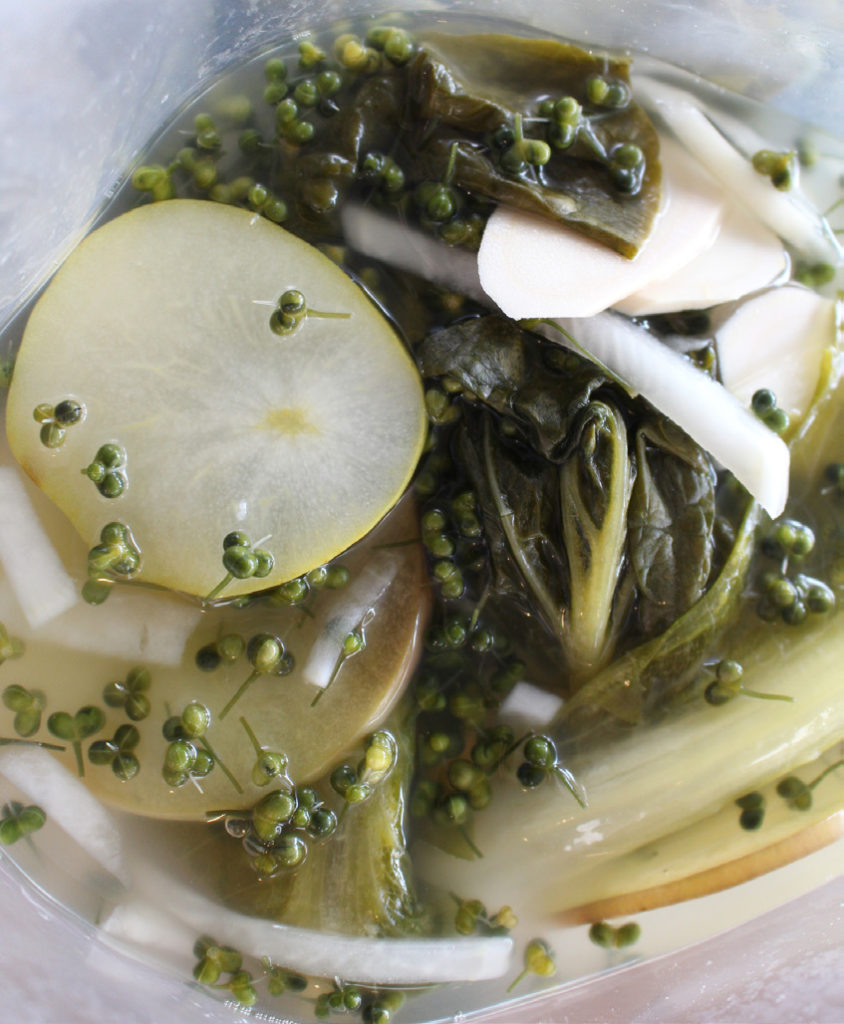
For about 4 months between April and July 2014, I tried many different prototypes of Nordic Kimchi with broad varieties of vegetables, fruits, wild plants, and algae. The main ingredient was decided by the season in Denmark. I made variations on Chinese cabbage, daikon, beetroot, white cabbage, red cabbage, pointed cabbage, butter-head lettuce, romaine, turnips, young radish, kohlrabi, and others. Among these, pointed cabbage and romaine turned out to make the best Nordic Kimchi. The texture was very crisp and crunchy, and it lasted quite a while with a consistent flavour and texture.
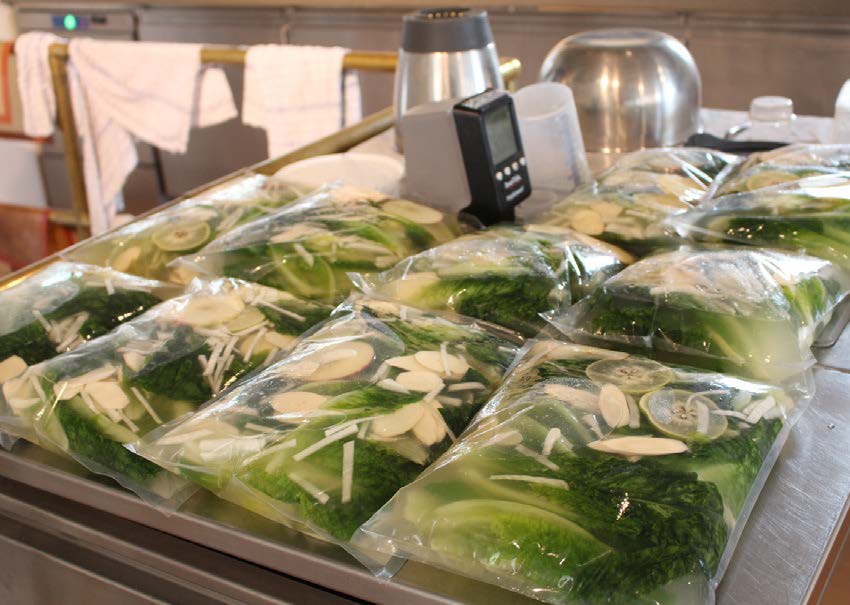
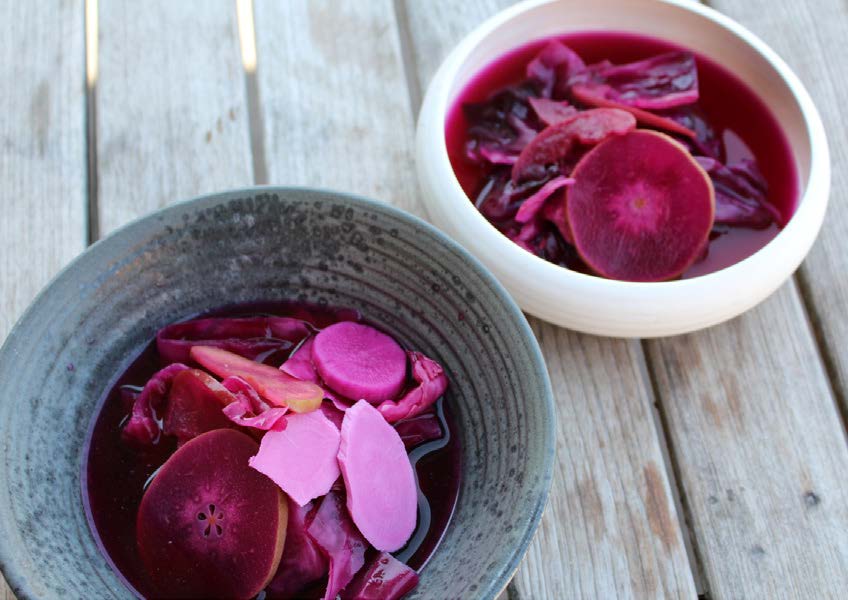
To find the most delicious pungent ingredients, I explored horseradish, mustards, white pepper, onion seeds, ramson, sand leek, garlic, and different types of onion. I made many attempts to find the best combinations of these different spices. Horseradish fit very well with Kimchi and it gave a great refreshing and pleasant flavour. When the controls without horseradish were compared to the trials with horseradish, it was obvious that the horseradish Kimchi had a longer edible period and kept a constant flavour, probably due to its anti-microbial property. It was a good substitute for the red chili powder of original Kimchi, and culturally in the Nordic region, it is quite common to use horseradish in cooking.
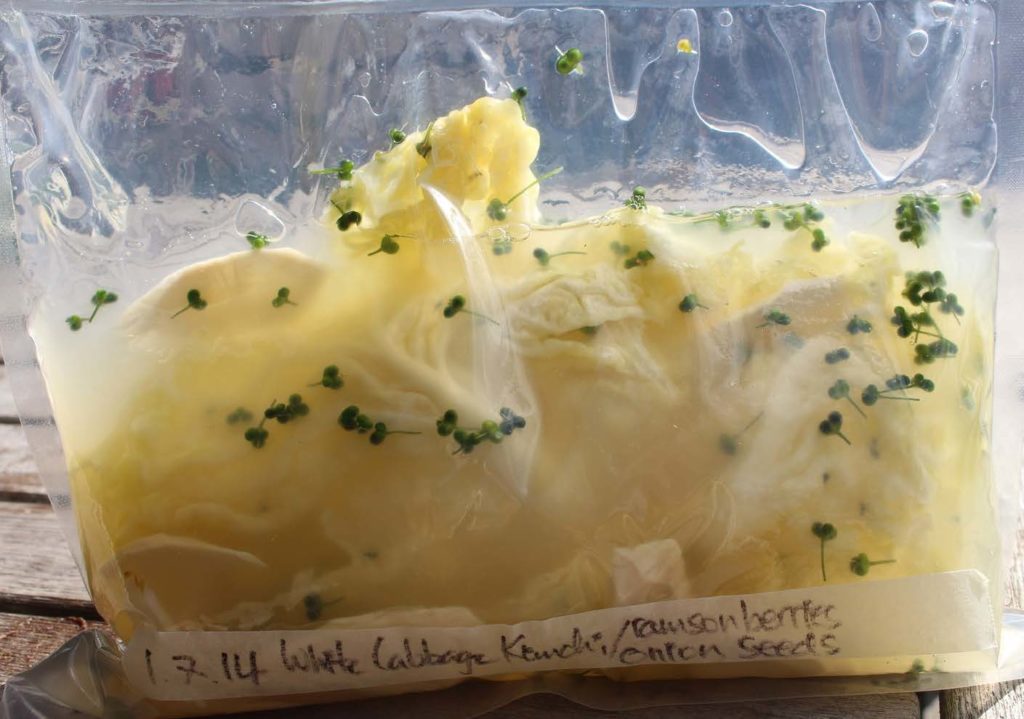
Several pungent wild plants were also tried. We foraged some ramson leaves and berries, and sand leek seeds from around Copenhagen. Ramson leaves and berries in particular added a fresh and pungent flavour, and they harmonized well with the horseradish. They also contributed to the tanginess of the Kimchi, which gives the fresh bubbling sensation on the tongue. The sand leek seeds contributed to the beautiful pink colour in Kimchi and the taste was good in the beginning of the fermentation; however, it became too bitter to eat after 3-4 weeks and they had a negative effect on the texture of the leafy vegetables. With the root vegetables like radish or turnip, the edible period was bit longer with an even more beautiful colour. Kelp and elderflower were also added to some trials. Kelp didn’t really affect the flavour which was different from the initial expectation that they would help increase umami in the Kimchi. Elderflower Kimchi was very floral and interesting, but after two weeks it became very bitter.
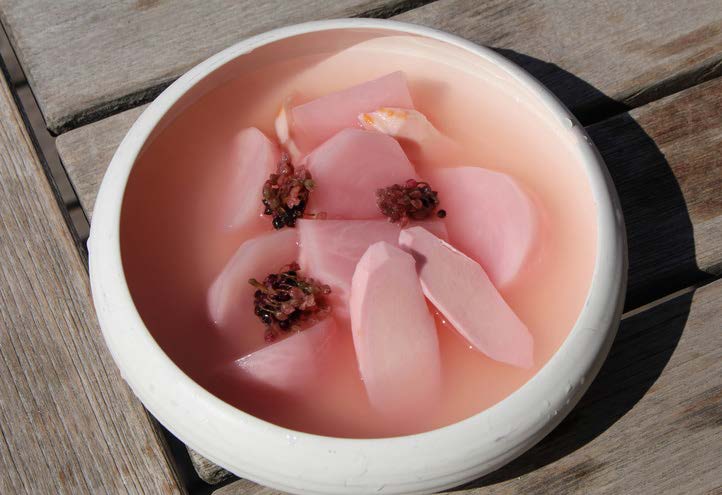
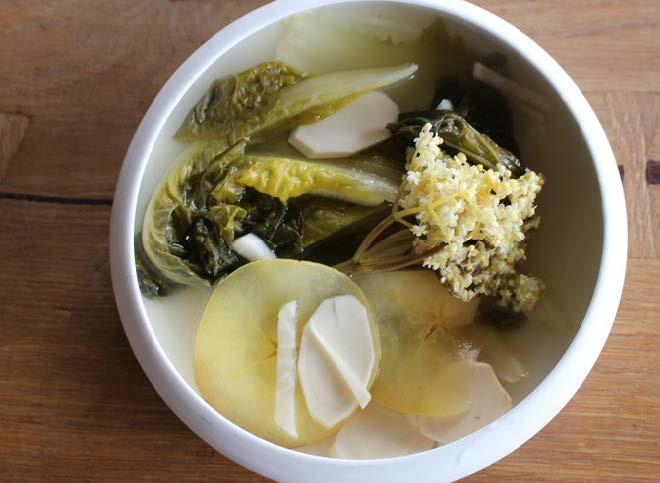
After we began gaining a picture of the best ingredients to use, the trickiest parts of the experiments were to find the best salt level and time duration for soaking the vegetables, the most proper salt level for the fermenting brine, the percentage of each ingredient added, the ideal fermentation temperature and time. From many different trials, I found the best recipe with romaine salad spiced with horseradish, ramson berries, and garlic. Additionally, onions and some fruits were used from the style of Korean summer Kimchi. So, here goes our best recipe of ‘Nordic’ Kimchi from among different versions.

Romaine Kimchi
300g romaine lettuce leaves
100g sliced horse radish
5-6 cloves of garlic
10-15g of ramson berries or leaves
1/2 white onion
2 apples
2 pears
30g barley flour
~100-120g sea salt
~4-5 L water
1. Wash the romaine thoroughly, and soak it in 5% brine for about 2 hours (need to check every 30 min the texture of the leaves, if the green part is softened and the stem part is softer than before but still snappy, then it’s ready).
2. Wash the romaine to remove all the salt and strain it until it is no longer dripping water but before it begins to dry out.
3. Boil 100g of water with 30g of barley flour to make a light porridge for about 6-8 minutes until it forms bubbles, and cool it down.
4. Peel all other ingredients (onion, garlic, apples and pears), blend them together in a thermomix, filter it through a very fine net (superbag) and reserve only liquid part (it is better to filter passively for a clearer liquid). Reserve the pulp for another purpose.
5. Make 2L of 2.5% brine (50g of salt + 1950g water) and mix with 50g of cooled barley porridge, and 100g of veg&fruits liquid.
6. Put all salted romaine, sliced horseradish, and ramson in the vacuum bag, pour in the prepared brine and seal.
7. Store at a cool temperature (10-15°C) for 3-4 days until the vacuum bag expands, which means the fermentation is active. Remove the air inside of the bag, seal it again, and move it to the fridge (4-5°C).
8. Store Kimchi in the fridge for about a week then it is ready to eat. Store for less time for less fermented taste, and longer time for more fermented and more sour taste – but then be careful of the leafy vegetables becoming soggy and too wilted.
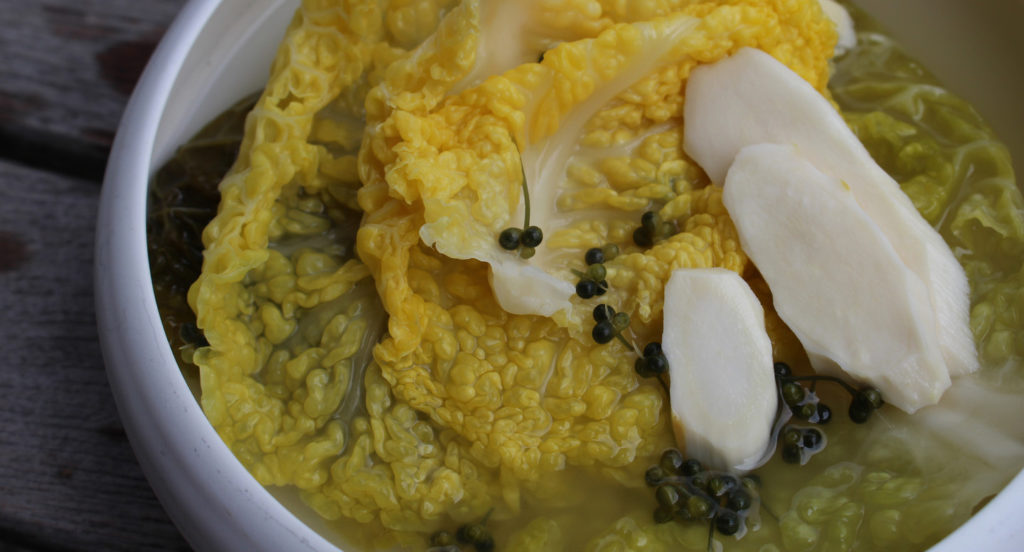
The time for soaking the vegetables differs depending on the type. For example, if the vegetable has more rigid body such as white cabbage, then it needs more time to soak in the brine. The amount of spices is adjustable according to one’s taste. If you want more pungent flavour, add more horseradish or ramson. Make sure the barley flour is fine enough to not make the brine too cloudy. For more fresh sweet flavour, you can add extra sliced apples or pears. I haven’t tried with other types of container for fermenting Kimchi, but whatever the container you use I would recommend making sure that all vegetables are submerged in the brine as they are fermented.
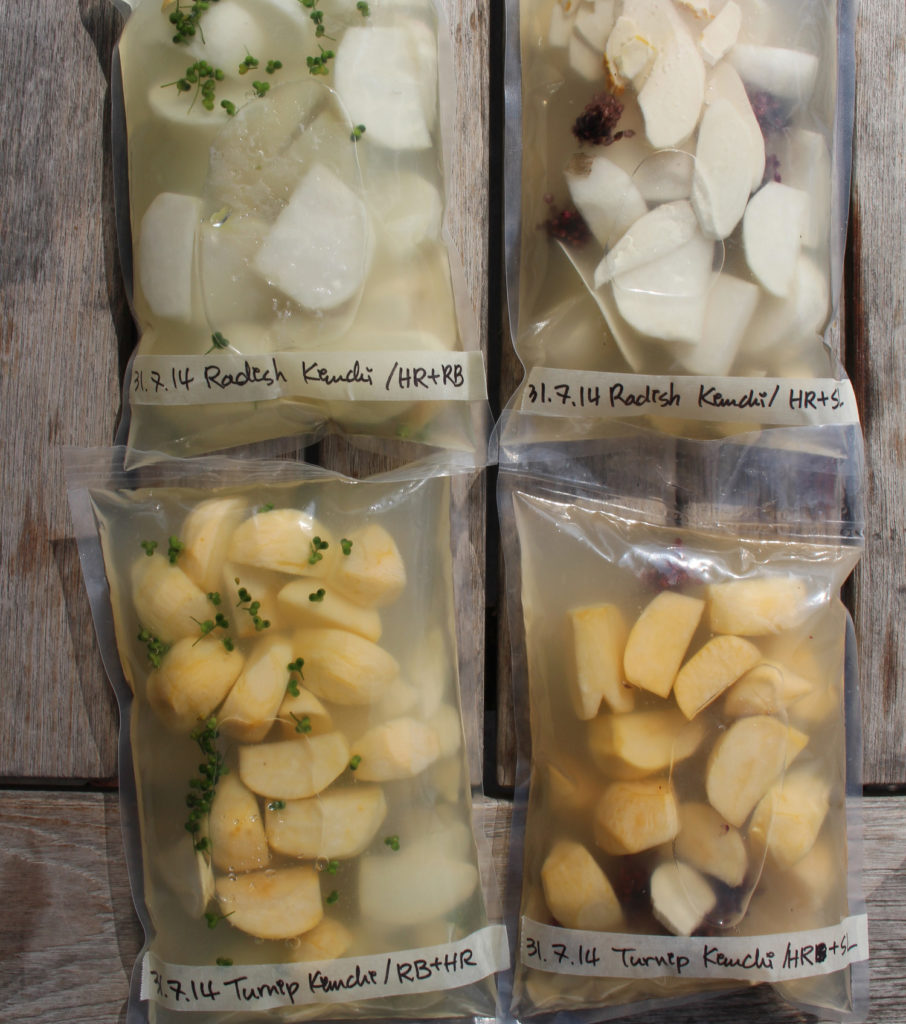
Further applications of ‘Nordic’ Kimchi
In Korea, Kimchi is used in many different ways in cooking, and especially the Kimchi juice is applied in various food preparation techniques. We put noodles in the Kimchi juice as a typical winter dish or we make a soup out of red Kimchi juice. Since the liquid part of Nordic Kimchi is also very refreshing, sour, salty, and also full of umami, we wanted to apply it in different ways.
I think this is where the project got really interesting. First, we tried to pickle different vegetables and fish in the Nordic Kimchi juice. Small vegetables such as baby carrot and baby cucumbers were pickled in Kimchi juice and stored in the fridge (4-5°C) for about 3-4 days, and baby cucumbers turned out very refreshing and tasty. It wasn’t too salty or too acidic, it was just right to eat in the salad or as a side dish of meal.
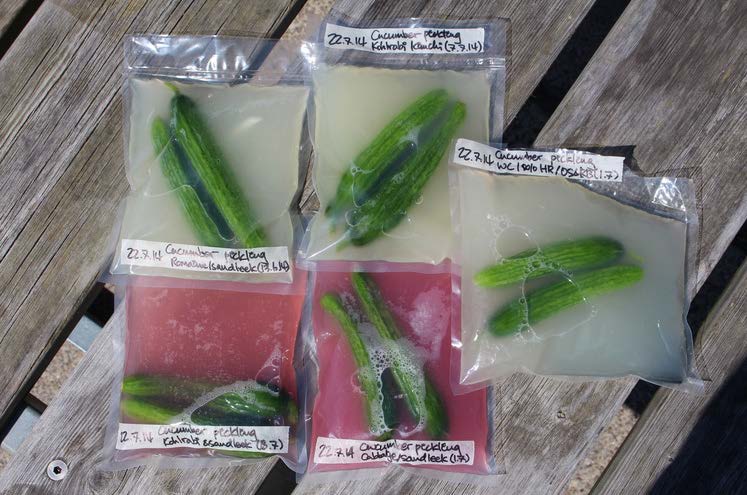
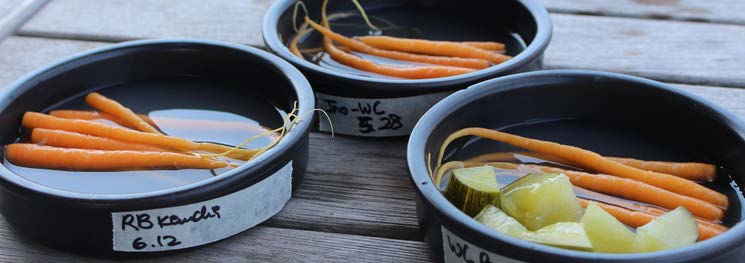
When mackerel was in season, we picked it in Nordic Kimchi juice with little bit of raw apple vinegar and onion. It was a good way to smooth any overly fishy smell and to soften the flesh of mackerel with acidity. At an event we did last summer called ‘Science at Sea’ held on the main harbour as part of the Science in the City festival organised by the City of Copenhagen, we served this dish as part of our menu: mackerel pickled in Nordic Kimchi juice with green apples and channelled wrackseaweed. The few hundred people we served enjoyed eating it even though most of them hadn’t tried Kimchi before. It could make a nice appetizer or also good snack on top of the bread, like Smørrebrød.
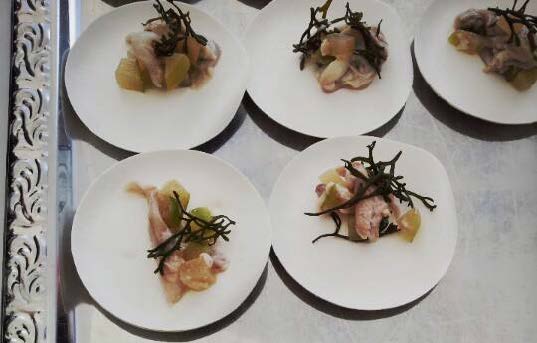
Then I tried dehydrating the Nordic Kimchi leaves and the juice. To minimize any changes on flavour and colour, the leaves and the juice were dehydrated below 35°C. Within a week, the leaves were still not totally crispy which was probably due to the low temperature, so the texture was still a bit chewy. But the flavour was very interesting. It was intensely salty but still sour with a good fermented taste of Kimchi. We fried some of the dehydrated Kimchi leaves and radishes and they were very savoury. We easily ate them just as a snack. I can see the potential of these dehydrated Kimchi as a beautiful and tasty garnish for a dish.
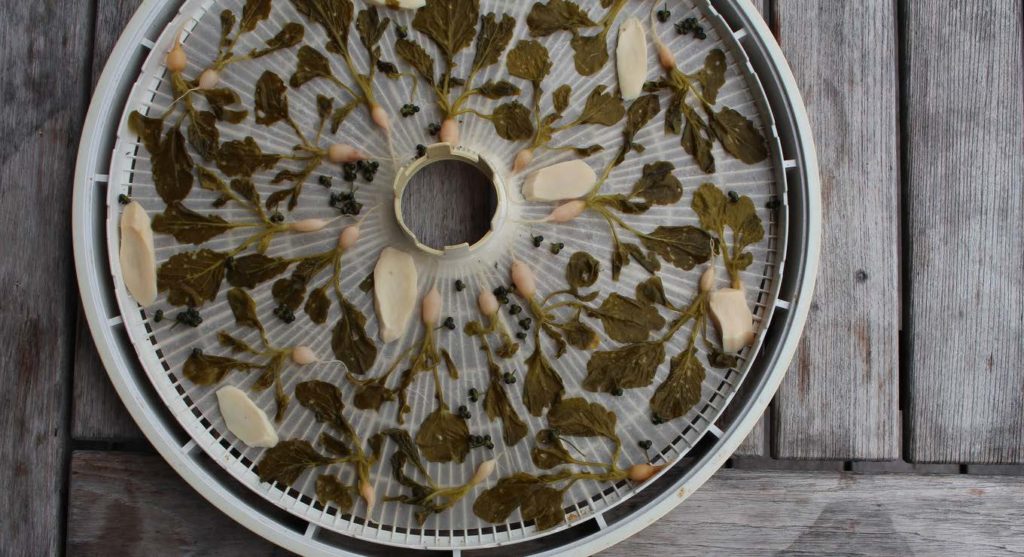
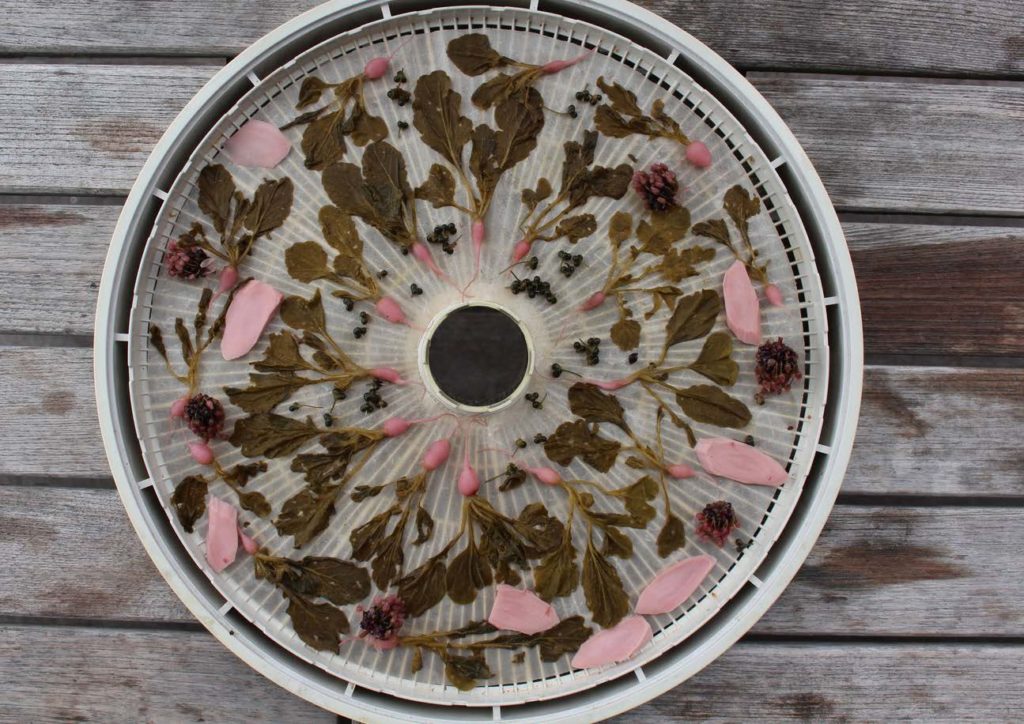
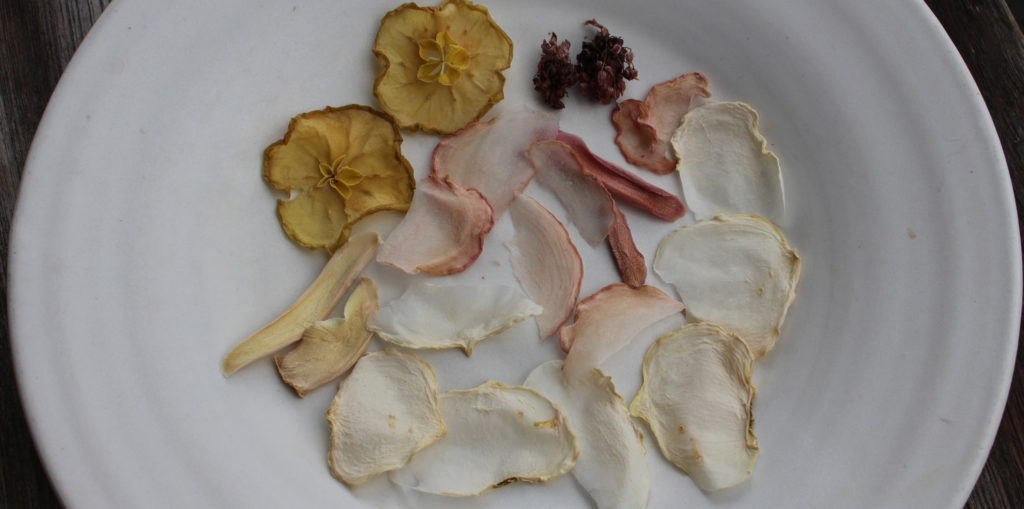
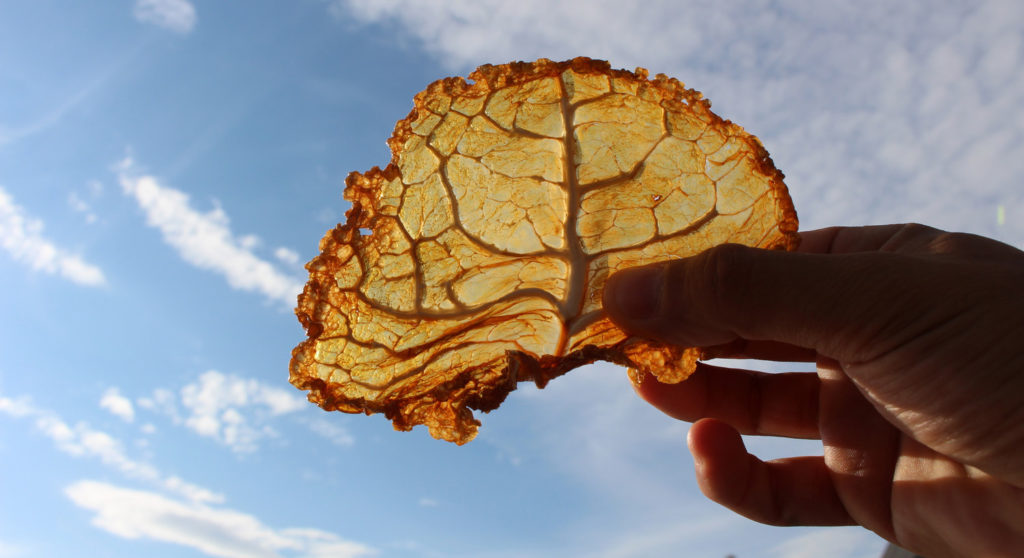
But the most interesting finding from dehydrating the Kimchi was actually the dehydrated Kimchi juice. It was also dehydrated below 35°C, but it seemed like some sort of caramelization was happening which made the colour, texture, and taste very different. Of course, these changes were also due to concentrating the juice, which already had many different contents. We called this dehydrated Kimchi juice ‘Kimchi salt’ since it was extremely salty with powerful umami and sourness. The flavour was very meaty and reminded us of wild mushrooms from the forest. The structure of it was also beautiful, a mixture of regular and irregular crystals. Looking at it through the sunshine was astonishing. We could easily imagine having a little bit of this Kimchi salt on top of vegetable salad or on bread with a soft layer of butter. It could also be a useful seasoning to give a powerful complex umami taste to a dish, especially one without meat.

Conclusion
Kimchi has great potential. It not only has beneficial impacts for our health, it is delicious with a balanced taste of saltiness, sourness and umami, and it can be applied many different ways in our cuisine. There are also many different ways to make Kimchi, just like this Nordic Kimchi which we created with certain geographical and cultural traits in mind. I am confident that we can also make all different types of Kimchi everywhere in the world with their own ingredients and adapted to their own conditions. Of course, every Kimchi won’t taste the same, which is the best part. I personally believe it is meaningful to share the identity of food between different cultures and it is interesting to re-create the taste and flavour of an existing food in other cultural and environmental conditions. So, if you are a big fan of Kimchi or any type of vegetable fermentation, I would like to recommend that you make your own Kimchi with your own bright ideas and little bit of craziness. It will make you surprised with joyful fermenting activity and unexpected great taste!
References
Chang, J.H., Shim, Y.Y., Cha, S.K., Chee, K.M. (2010), Probiotic characteristics of lactic acid bacteria isolated from kimchi, J Appl Microbiol.; 109, 220–230
Han, Y. S., Park, I. S., Bum, B. S., Kang, M. W., Yoon, J. A., Park, H., Park, H. N., Gwon, G. H. (2012), Fermented Food (발효식품), Ch. 3 Kimchi (김치), 파워북 (Powerbook), Seoul, Korea
Jeong, J. K., Kim, Y. W., Choi, H. S., Lee, D. S., Kang, S. A., Park, K. Y. (2011), Increased quality and functionality of kimchi when fermented in Korean earthenware (onggi), Int J Food Sci Technol., 46, 2015–2021
Jung, J. Y., Lee, S. H., Jeon, C. O. (2014), Kimchi microflora: history, current status, and perspectives for industrial kimchi production, Appl Microbiol Biotechnol.; 98(6): 2385–2393.
Kim, M. J., Lee, K. T., Lee, A. R. (1996), Kimchi: The Taste of Thousand Years (김치 천년의 맛), Design House (디자인하우스), Seoul, Korea
Ko, K. H., Liu, W., Lee, H. H., Kim, I. C., (2013), Biological and Functional Characteristics of Lactic Acid Bacteria in Different Kimchi, J Korean Soc Food Sci Nutr (한국식품영양과학회지), 42(1), 89~95
Lee, H. J. (2000), A Study on Kimchi, or Korean Traditional Dishes, Culture, 비교민속학 제18집 (2000. 2) pp.85-99 1598-1010 KCI
Noh, J. S., Kim, H. J., Kwon, M. J., Song, Y. O. (2009), Seasonal Changes in Quality of Chonggak Kimchi Fermented at Different Temperatures, J Korean Soc Food Sci Nutr (한국식품영양과학회지), 38(6), 742~749(2009)
Park, C. L. (2005), 한국의 김치문화와 김치의 문화적 특성 (The Kimchi Culture in Korea and its Cultural Characteristics), Food Preservation and Processing Industry, Vol.4, No.1,
